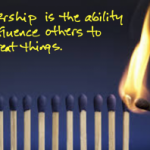Admit it. We feel better when we are solving problems, fixing things, repairing stuff, or creating something new. As business owners / leaders we pride ourselves based on DOING. We are not fond of unresolved issues lingering around much. Yet, not all “issues” may be meant to be solved! In fact, solving an issue may generate more problems and unwanted side effects. So it is important to distinguish between a problem to solve or a tension to manage.
For leaders, we are tempted to solve things or do things ourselves when those we serve come to us and interrupt our work. By “solving” this problem by making ourselves less accessible, the message sent could be we are unapproachable, we do not care, and so forth. Other common dilemmas … customizing / tailoring our products and services to our clients / customers vs. developing efficiencies by systematizing our deliverables, attracting the best talent vs. managing costs, being flexible and understanding vs. holding people accountable and managing performance.
Similarly, as parents we might lean into the urge to do or fix things for our children, rather than allowing them to struggle and make mistakes. Seeing these situations a problems to solve, we hinder growth and development.
The alternative is reframing these situations as tensions to manage. It is embracing the dissonance and friction and polarity that enables us to look beyond the current issue. Reframing prompts us to rephrase the question from focusing on the problem (e.g., How can I fix this?) to focusing on the tension (e.g., How can I do this AND this?). This is similar to polarity thinking which shifts the perspective from either / or (problem) to both / and (tension). What is the upside of each position? What is the downside? How do we access the best of both while avoiding as much of the negative as possible?
To aid ourselves in determining if we have a tension to manage or a problem to solve consider the following …
- Balance. Are there valid positions on both sides of the issue?
- Risk. If you solve this issue, is there an apparent risk? What’s at stake … short-term and long-term?
- Creativity. By seeing this issue as a tension with two or more sides, is creativity sparked?
A final thought … when dealing with people and relationships, we are instructed to “love one another.” Thus, our default position and starting point with human beings — who are made in the image and likeness of God — is LOVE. And LOVE may be the ultimate tension to manage!











{ 0 comments… add one now }